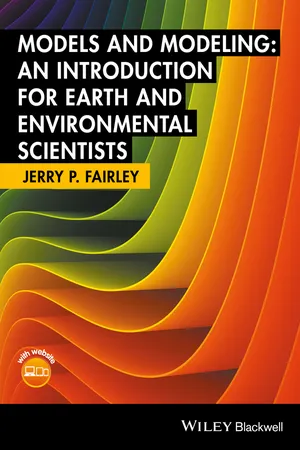
Models and Modeling
An Introduction for Earth and Environmental Scientists
- English
- ePUB (mobile friendly)
- Available on iOS & Android
About This Book
An Introduction to Models and Modeling in the Earth and Environmental Sciences
offers students and professionals the opportunity to learn about groundwater modeling, starting
from the basics. Using clear, physically-intuitive examples, the author systematically takes
us on a tour that begins with the simplest representations of fluid flow and builds through
the most important equations of groundwater hydrology. Along the way, we learn how
to develop a conceptual understanding of a system, how to choose boundary and initial
conditions, and how to exploit model symmetry. Other important topics covered include
non-dimensionalization, sensitivity, and finite differences. Written in an eclectic and readable
style that will win over even math-phobic students, this text lays the foundation for a
successful career in modeling and is accessible to anyone that has completed two semesters
of Calculus.
Although the popular image of a geologist or environmental scientist may be the rugged
adventurer, heading off into the wilderness with a compass and a hand level, the disciplines
of geology, hydrogeology, and environmental sciences have become increasingly quantitative.
Today's earth science professionals routinely work with mathematical and computer models,
and career success often demands a broad range of analytical and computational skills.
An Introduction to Models and Modeling in the Earth and Environmental Sciencesis written for
students and professionals who want to learn the craft of modeling, and do more than just
run "black box" computer simulations.
Frequently asked questions
Information
CHAPTER 1
Modeling basics
Chapter summary
1.1 Learning to model
1.2 Three cardinal rules of modeling
- Always know exactly the objective of model development.
- The model you develop should be appropriate for the available data.
- Start with the simplest possible model of the system, even if it is completely unrealistic. Once you thoroughly understand this preliminary model, add complexities to the model one at a time until you arrive at a satisfactory representation of the system.
1.2.1 Rule 1: Know your model objective
1.2.2 Rule 2: Make your model appropriate for your data
1.2.3 Rule 3: Start simple and build complexity
1.3 How can I evaluate my model?
1.3.1 Test model behavior in the limits



1.3.2 Look for behavior congruent with the governing equations
Table of contents
- Cover
- Title Page
- Table of Contents
- About the companion website
- Introduction
- CHAPTER 1: Modeling basics
- CHAPTER 2: A model of exponential decay
- CHAPTER 3: A model of water quality
- CHAPTER 4: The Laplace equation
- CHAPTER 5: The Poisson equation
- CHAPTER 6: The transient diffusion equation
- CHAPTER 7: The Theis equation
- CHAPTER 8: The transport equation
- CHAPTER 9: Heterogeneity and anisotropy
- CHAPTER 10: Approximation, error, and sensitivity
- CHAPTER 11: A case study
- CHAPTER 12: Closing remarks
- APPENDIX A: A heuristic approach to nondimensionalization
- APPENDIX B: Evaluating implicit equations
- APPENDIX C: Matrix solution for implicit algorithms
- Index
- End User License Agreement